WHY SHOULD I VISIT ZAMBIA?

Iconic Zambia – South Luangwa – photo courtesy of the Bushcamp Company
Here are the top five reasons why you should visit Zambia?
- Victoria Falls Zambia
- South Luangwa – home of the walking safari and one of Africa’s best safari destinations
- Lower Zambezi – safari mixed with all the mighty Zambezi has to offer
- Kafue National Park – one of Africa’s last true wildernesses
- Liuwa Plains – vast plains and spectacular wildlife
Zambia is blessed with one of the continents great rivers, the Zambezi River. Known for its beauty and wildlife, few places offer a richer ‘bush’ experience and a place to get away from the hustle and bustle. The original home of the walking safari, the South Luangwa is one of my favourite safari destinations and walking safari cannot be topped. The Kafue and Liuwa Plains are still off-the-beaten-track and offer safaris in some of the last truly unspoilt wilderness areas of Africa.
What is the best time to visit Zambia?

Secret season in the Luangwa Valley
The best time to travel to Zambia depends on what you are travelling to Zambia to experience.
For safari, the best time is the dry season which is June to November.
For birding, the best time is the wet season from December to April
If you want to see the Victoria Falls when it is full of water, March to May is the best time
Zambia has a subtropical climate and as such is mainly warm to hot during the day and pleasant at night except during the coldest months, June to August, when it can get quite cool, especially in southern Zambia.
Which places should I include in my visit?

The beauty of the lower Zambezi from a canoe
Victoria Falls, one of the seven natural wonders of the world, is a must for any itinerary. The best overall safari destination is the South Luangwa which also offers the best walking safaris in the world not to mention game drives and in the wet season, boat cruises. The Lower Zambezi is a great combination of safari and activities on the Zambezi river like canoeing, boating, fishing and in some places mokoro.
If it is an unspoilt, off-the-beaten-track safari experience you are after, Kafue and Liuwa fit the bill. I would suggest that Kafue would be my first choice as it is more developed for tourism and offers a wider choice of accommodation and experiences. Liuwa Plains would be my suggestion for repeat visitors to the country.
Once a year for about a month, the largest mammal migration occurs with the best place to observe this phenonmenum is in Kasanka National Park. This bat migration occurs between October and December and involves about 10 million fruit bats that descend on a tiny swamp forest.
Other places to visit are the North Luangwa (not well-developed for tourism at all), Benguela swamp and lake system and Lake Tanganyika. These are best visited as part of an arranged tour.
Lake Kariba is a great place to take a few days to chill on a houseboat and watch wildlife while doing so.
How long should I visit Zambia?
- For a very short stay of 2 or 3 nights, I suggest that you visit the Victoria Falls
- For a stay of 3 or 4 nights, South Luangwa, Lower Zambezi and Kafue would be your options
- For a stay of longer than 4 nights I would suggest a combination of any of the above as they all can be accessed by light aircraft.
- If you want to include a walking safari, you will have to have 5 nights or more and some walking safaris can be up to 10/11 nights.
What is the weather like in Zambia?

Luangwa River in flood – Nkwali – Robin Pope Safaris
The climate varies between subtropical on the plateau and tropical in the low-lying areas. While the seasons in Zambia are not that defined, as far as temperatures go, Zambia, especially the south, does experience the traditional 4 seasons. October to March are summer, April & May, autumn, June to August, winter and September is spring. The rains start mid-November and carry on until end of March, with some rain possible in April. May to October are the dry months. The winter months of June to August can get quite cold at night and are sometimes cool during the day. October is the hottest month. During the summer it can be quite humid.
The rain comes in the form of thundershowers or downpours. During the wet season, also called the green season, the rivers flood and big areas of the South Luangwa, Kafue and Liuwa Plains are covered in water and only accessible by boat. The Zambezi also floods and some lodges close during this period as a result.
The southern and eastern part of the country, especially the Zambezi Valley, are the low-lying areas. The higher-lying areas, the Plateau and mountains are found in the central and north of the country. Between the two ranges of mountains in the north, you will find the Benguela Swamps.
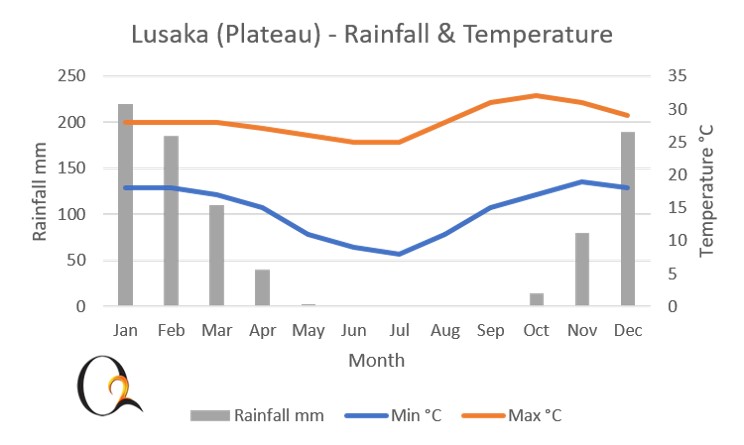
Lusaka & Central Plateau Climate Chart

Zambezi Valley and low-lying areas Climate Chart
Do I need a visa to travel to Zambia?
Visa requirements fall into 3 categories; Those that do not require a visa to visit Zambia, those that do need a visa but can also get their visa on arrival and those that must have a visa prior to travel.
Visa can be obtained in one of 3 ways: Online, at a Zambian High Commission/Embassy or on arrival. Please check before you travel what the requirements are for your country.
A KAZA Uni visa is available at port of entry. It allows access to Zambia, Zimbabwe and Botswana on the one visa. Again, the above methods of obtaining the visa must be checked before travel.
What are the health requirements for Zambia?
Zambia is a malaria risk area. Anti-malaria medication is recommended, and you should consult your doctor in this regard. To minimise the risk of contracting malaria, wear long trousers and cover your arms in the evening, and apply mosquito repellent.
A Yellow fever vaccination is required if you are coming from an endemic country. The following vaccinations are recommended, but not compulsory:
- Hepatitis A & B
- Typhoid
- Tetanus, Diphtheria & Pertussis (TDAP)
- Mumps, Measles and Rubella (MMR)
- Chickenpox
- Shingles
- Pneumonia
- Influenza
- Rabies
- Meningococcal meningitis
How can I travel around in Zambia?
Taxis are readily available in Zambia. The public bus service is reasonable and both long range and local busses are available, but they often do not stick to scheduled times. With over 10000km of tar roads, self-drive is an option, but the state of the roads is not always good, especially after heavy rains. We suggest that you travel with tools, some spares and extra fuel. The ground roads are dicey to travel on as the state of these roads can vary from terrible to okay, again, season dependant.
The best way to travel around Zambia by light aircraft. It is expensive but not exorbitantly so. There are a host of travel companies that will transfer you to most tourist hotspots in, for the most part, good quality, comfortable, air-conditioned vehicles.
Train travel in Zambia is not recommended.
TOP TOURIST ATTRACTIONS
Victoria Falls

Devils Pool – look over Falls into the canyon below
The Victoria Falls are shared by Zimbabwe & Zambia, with approximately 1/3 being in Zambia. During low-water (July to November), the Zambian side of the falls can dry up in low rainfall years.
None of the hotels or lodges have a view of the Falls with only one resort being a few hundred metres from the Falls themselves. The majority of the hotels and lodges are scattered along the banks of the Upper Zambezi (part of the Zambezi River above the Falls) with a handful overlooking the Batoka Gorge below the Falls or the town of Livingstone.
Victoria Falls is one of the world’s best adventure capitals. Activities include: white water rafting, bunjee jumping, flying fox, abseiling, hiking, bridge swing, boat trips, jet boats, helicopter flights, canoeing, fishing, horse riding, historical train trips, swimming while looking over the Falls and quite a few more.
While most people stay for only a couple of nights and experience a tour of the Falls and a sunset cruise, I would recommend, for those that enjoy adventure activities, that you stay 5 nights or longer as there is more than enough to keep you busy.
The Zambian side of the Falls, as opposed to the Zimbabwean side, does not have a town right at the Falls, thus the hotels and lodges tend to be spread out and you feel more secluded. This also means that, other than the restaurants at the hotel, you cannot just walk to another restaurant for dinner.
Livingstone City
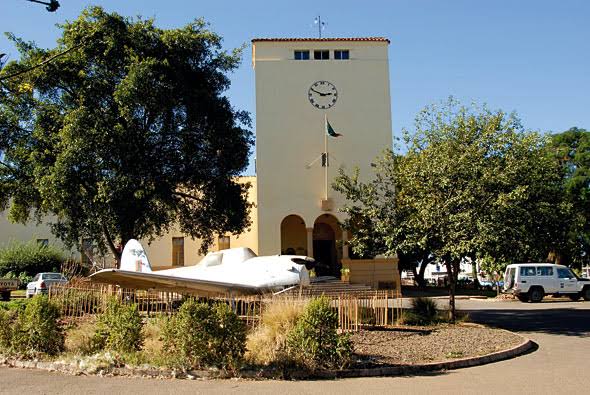
David Livingstone Museum in Livingstone
Livingstone city is about a 15min from the Victoria Falls. The Livingstone International Airport is close by and is the gateway, along with Victoria Falls International Airport in Zimbabwe, to the Victoria Falls.
While Livingstone is a business centre and has a few hotels and guest houses, it essentially owes its existence and prosperity to the Zambezi River and the Victoria Falls. To experience Livingstone may include a visit the Livingstone Museum, a village tour or shopping at the Dambwa Market.
Kafue National; Park
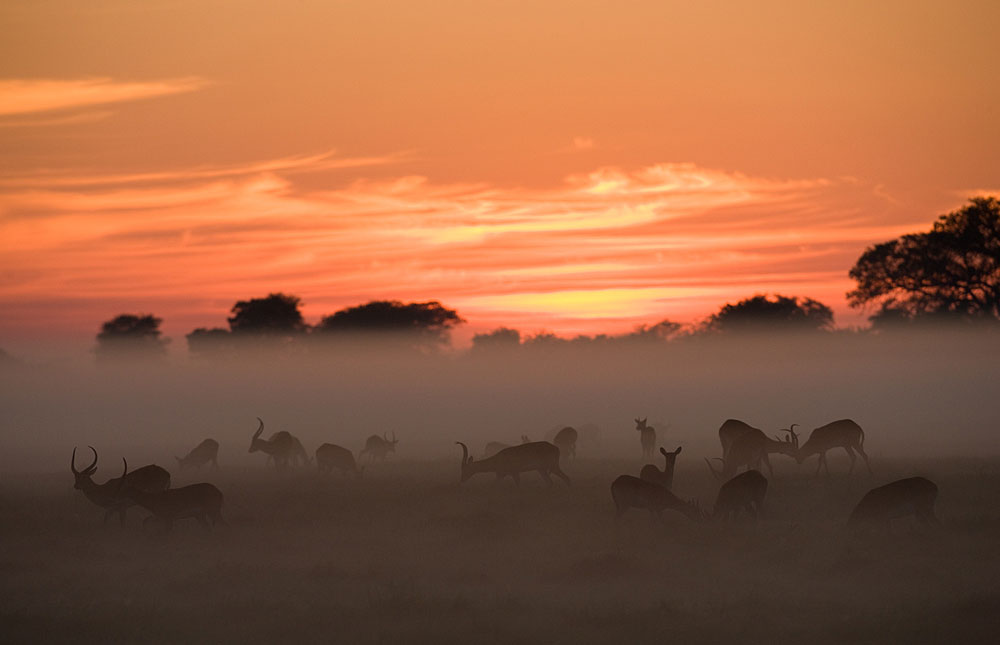
Mist on the Kafue at dawn
Kafue is Zambia’s biggest national park, coming in at 22 4000 km². Kafue, which is located in western Zambia, only 2 hours from Livingstone, is mostly flat with the scattered hills and rocky outcrops. The soil in the southern areas is sandy and that in the north has a higher clay content, which is the reason that the Busanga Swamps are found in the north. The park is predominantly savannah and miombo woodland with a riverine forest along the banks of the Kafue River. Animals are attracted to the Busanga swamps and permanent river courses. The Kafue river is dammed just outside the boundaries of the park and the Itezhi-tezhi Dam has become a feature of the area.
The Kafue is one of the best places to encounter leopard and also boasts 3 more of the Big 5 (rhino has been poached out). It has, arguably, the largest population of Wild Dog in Africa, thus the world. While none of the eastern national parks in Zambia have cheetah, Kafue is home to a small population of these cats. Kafue has the largest diversity of ungulates (hoofed animals) in southern Africa.
With over 500 species of bird having been recorded, Kafue is an excellent birding destination, particularly in the summer months.
It is best to visit the Kafue during the period between April and November, with July to October the very best months.
Liuwa Plains National Park
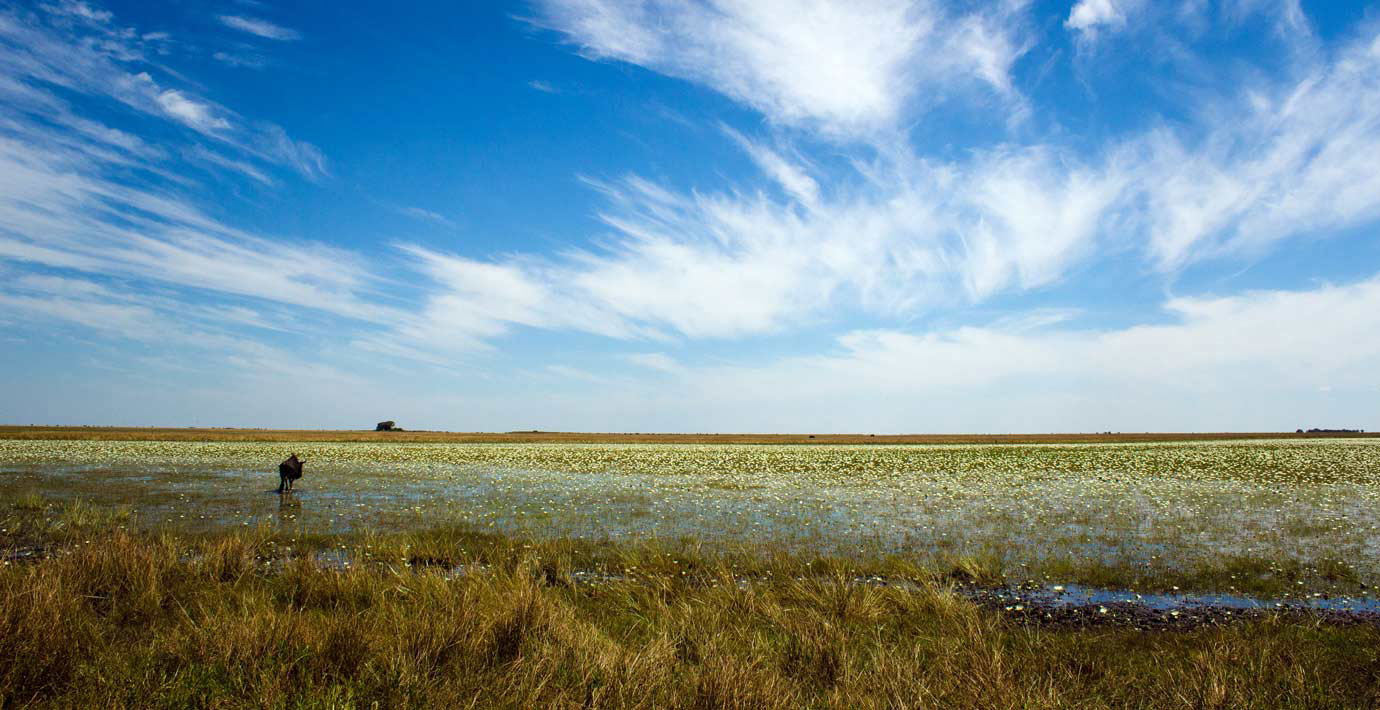
The vastness of the Liuwa Plains
Liuwa Plains is in the north west part of Zambia. It is remote and wild. As the name suggests, the national park is mainly grassy plains with the occasional island of trees, corpses of raffia palms and especially towards the centre, a few pans. The plains flood each year from December to April. The floodwaters start in the north and move to the south. The vast herds of wildebeest migrate south in front of this encroaching water and back again when the water retreats in the dry season. Some of the pans in the central area retain water well into the dry season, providing water for the resident populations of animals. The Liuwa wildebeest migration, often referred to as Africa’s second biggest, involves some 45000 animals that migrate from Angola in the north onto the Liuwa plains and back.
The park is home to huge herds of zebra and wildebeest and growing populations of lion and cheetah. Wild dogs are present, but rarely seen.
It is the sheer vastness and remoteness of Liuwa, along with the wildebeest migration, that are the main reasons to visit.
South Luangwa National Park

Wild dogs of the South Luangwa
South Luangwa National Park is in eastern Zambia and is 9059 km². As the name suggests, the park is dominated and characterised by the Luangwa River. The river floods annually between December and March (green season) when most of the park finds itself under water. When the waters retreat as the dry season sets in, they leave oxbow lagoons/lakes and the main river course itself, becomes a series of waterholes in certain places. Most of the park is flat, but in the north and west the Muchinga Escarpment forms the boundary. This is end of one of the spurs of the Great Rift Valley that starts in the Dead Sea in Israel.
While the river is littered with crocodiles and hippo, the clear waters of the shallow tributaries namely: the Luwi, Mwamba and Kampamba Rivers play host to most of the walking safaris in the South Luangwa. These rivers do not have crocodiles and hippos so walking is quite safe.
Known as one of the best wildlife experiences in the world, the South Luangwa has dense concentrations of animals along the river and its low vegetation affords excellent animal sightings. There are no rhino in the park, but the rest of the Big 5 are present in great numbers.
While there are several lodges in the park itself, most of the lodges are concentrated on the eastern bank of the Luangwa River. As there are no fences, wildlife is free to wonder to-and-fro across the river and they do. This effectively means that these lodges are accessible even during the annual flood as Mfuwe, the entry point to the area, is about 45min drive east of the park gate and not affected by the flood waters.
With over 450 species of birds, South Luangwa has much to offer the serious birder.
The park is easily accessible from Mfuwe, which is turn can be accessed by car or air.
North Luangwa National Park

North Luangwa Conservation Programme
The park is found just north of the South Luangwa National Park. It is only about half the size as its southern cousin. With about a quarter of the park in the Muchinga Escarpment, it is much more rugged, wild and has a greater diversity of habitats making it scenically more interesting. The diversity of habitats means more species of birds have been recorded. As with the South Luangwa, it is dominated by the Luangwa River, with much the same wildlife.
Safaris in the North Luangwa are limited to walking safaris and a 3-night extension to your stay in the South Luangwa or as a stand alone safari is quite sufficient as there are few roads and little infrastructure. There are only a handful of camps in the park that are open during the dry season, namely June to October.
The park is accessed by flying into Mfuwe.
Lower Zambezi National Park
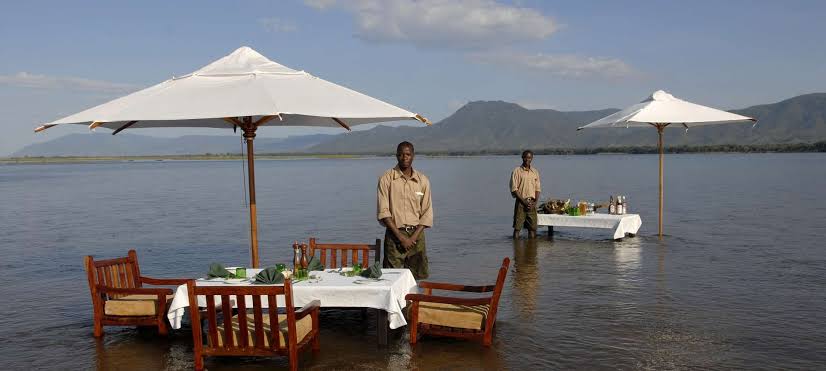
Who said the Lower Zambezi could not be adventurous?
Situated in the lower Zambezi valley in south eastern Zambia, the Lower Zambezi National Park is Zambia’s newest. It is directly across the river from the famous Mana Pools National Park in Zimbabwe. The national park is part of a game management area that is quite a bit bigger than the park itself. As it is not fenced, animals move freely between the park and game management area.
Sandwiched between the Zambezi escarpment in the north and the Zambezi River in the south, the intervening floodplain is covered in forest, woodlands and savannah. UNESCO has declared parts of the National Park as heritage sites, due the great concentration of game they support.
The appeal of the Lower Zambezi National Park is that the normal safari activities are supplemented by boating, canoeing, fishing and even having intimate dinners or breakfasts in the water surrounding one of the numerous islands in the Zambezi River. The mountains and mighty river provide the backdrops to a superb safari experience.
The park is known for its huge herds of buffalo and elephant. Some elephant can at times be seeing swimming over the river between Zimbabwe and Zambia. The park also has a healthy population of lion and leopard.
With over 400 species of birds, birders would appreciate a visit to the park.
The park is easily accessible by light aircraft from Lusaka.
Kasanka National Park
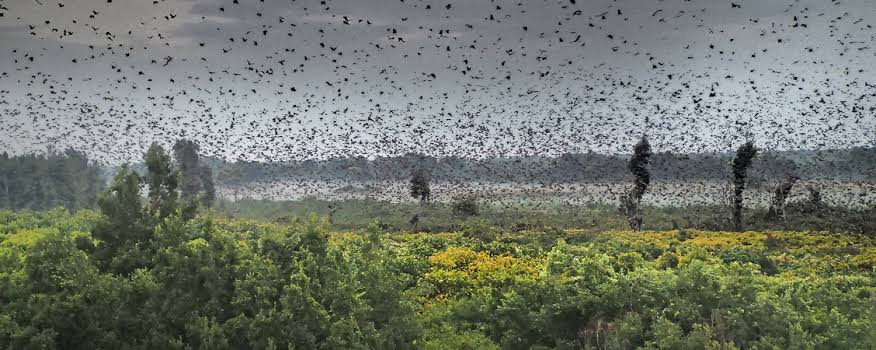
Bats at dusk in the Kasanka National Park
Kasanka National Park is Zambia’s smallest. Kasanka is most well known for the over 10 million straw-coloured fruit bats that descend on a small patch of forest, the Mushitu (swamp forest), between October and December each year and consume about 330 000 tons of fruit during this short period.
Of interest is that the park has 5 perennial rivers flowing into the park with only the Luwomba River flowing out. The Luapala River, which drains the Bangweulu Wetlands is joined by the Luwomba River and together they form the major source of the Congo River.
The park has 114 species of mammals including leopard, elephant, buffalo, zebra, sitatunga, puku, Lichtenstein’s hartebeest, roan and sable antelope. There are over 330 species of bird recorded in the park.
Bangweulu Wetlands

Water, water and more water in the Bangweulu Wetlands
The Bangweulu wetlands are adjacent the Lake Bangweulu and is roughly the same size as the South Luangwa National Park. Fed by 4 perennial rivers, the swamps flood annually during the wet season. The Luapala River, a major tributary of the Congo River, drains the wetlands. The wetlands are a Ramsar site and are currently managed by a partnership between African Parks, Zambian Department of National parks and the local communities.
With over 75000 black lechwe, buffalo, zebra and a host of rare antelope, the park has particular significance both as a wetland and as a wildlife sanctuary. Over 400 bird species have been recorded which includes the Shoebill Stork and over 10% of the world’s wattled cranes.
Lusaka City
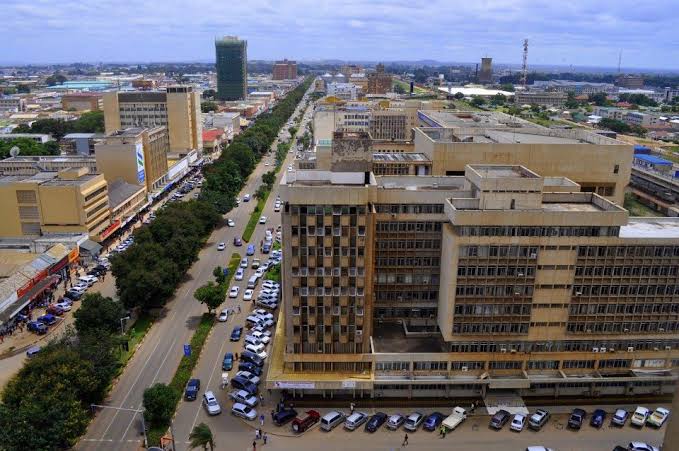
Lusaka
Lusaka is the capital city of Zambia. It is the entry point for most people that want to travel to the South Luangwa, Lower Zambezi, Kafue, North Luangwa, Bangweulu Wetlands and Lake Tanganyika.
While just another African city, if you need to spend time in Lusaka you may find the following of interest:
The National Museum
The Freedom Statue
Lilayi Elephant Nursery
Munda Wanga Environmental Park
Contact Q2 Travel for more information and if you are interested in visiting this beautiful country. A world of adventure awaits when you make Zambia your destination of choice.
GENERAL INFO & HISTORY
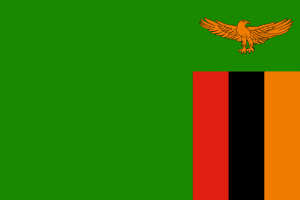
Zambia Flag
The republic of Zambia is a land locked country in southern Africa. It has borders with 8 countries, namely: Zimbabwe, Botswana, Namibia, DRC, Malawi, Angola, Mozambique and Tanzania. It is 752618 km² in size and has a population in excess of 17 million. It has 8 official languages, including English
Brief History
The Khoisan were the earliest modern inhabitants of Zambia. Essentially hunter-gatherers, they lived off the land and did participate in agriculture. The Bantu people moved down into Zambia from the north around the 4th century AD. They lived in self-sufficient villages. They were agriculturalists and herdsmen and practised a slash-and-burn policy, clearing land for their crops and cattle and when the land was exhausted, moving to new land and repeating the process. This expansion into Zambia displaced the Khoisan who were killed, retreated to more remote areas or became assimilated with the Bantu. Zambia is rich in copper and slowly the Bantu tribes began to trade with the outside world, particularly in copper, ivory and cotton.
Between the 16th and 19th centuries four Bantu kingdoms emerged, the Kazembe-Lunda, Chewa, Bemba and Lozi. The first European to set foot in Zambia was Manuel Caetano Pereira in1796. His goal was to establish a trade route from Mozambique to Angola and in pursuit of this goal, he had to consult the Kazemba chief. Some Portuguese settled on the west bank of the Luangwa River in 1820.
David Livingstone started his exploration of the upper Zambezi in 1851 and became the first European to see the Victoria Falls (Mosi-ua-Tunya).
The Lozi Kingdom of Barotseland (upper Zambezi River) and the Kazembe kingdom around the Luapala River had emerged as the strongest kingdoms in Zambia by the time European explorers reached Zambia. Defeated by Shaka’s zulus and displaced by the expanding Zulu kingdom, some Basotho or Tswana people became known as the Makololo. The Makololo fled to Barotseland and conquered the Lozi, inserting themselves as the Lozi elite. Just after the mid-19th century, the power of the Makololo had waned and the Lozi defeated them, forcing them to flee to Malawi.
It was about this time that the European hunters and traders started to settle in Zambia/Zimbabwe. In 1888, Cecil John Rhodes completed negotiations to obtain the mineral rights with the local chiefs. The British sphere of influence over Southern and Northern Rhodesia was proclaimed later in 1888. Cecil John Rhodes was given the mandate to administer the colony through his British South Africa Company (BSAC). The British however revoked this arrangement in 1923, split Southern Rhodesia and Northern Rhodesia, giving Southern Rhodesia the right to self-government and declaring Northern Rhodesia a protectorate. Livingstone became the capital city in 1924 but Lusaka assumed this role in 1935. A Legislative Council was formed but representation was restricted to the British colonials only.
It 1928 the history of Northern Rhodesia was changed forever. Huge copper deposits were discovered and two companies, namely the Anglo American Corporation and the Rhodesian Selection Trust (RST), developed this new found wealth. This significantly changed the economy of Northern Rhodesia from a mainly agriculture exporter to a supplier of 13% of the world’s copper.
In 1953, the British merged Southern and Northern Rhodesia and Malawi into the Central African Federation. In the years leading up to independence, the Africans of Northern Rhodesia were starting to demand greater representation in government and the British, who were afraid of losing control of the country, resisted.
In 1962, as a result of the elections, the Africans assumed control of the Legislative Council. The Northern Rhodesians had been pushing for secession from the federation and the right to self-government for some time. In October 1964, Northern Rhodesia was granted independence and became the Republic of Zambia with Kenneth Kaunda as its prime minister and then president.
Zambia soon realised that there were few non-British people that had the skills to run a country, which resulted in a decline of the fortunes of Zambia,
On winning the election in 1968, Kenneth Kaunda pushed forward with his African socialist ideological agenda, namely nationalisation, central planning and control and a one-party state. By 1972, all other political parties were banned and the one-party state was enshrined in the new constitution. Kaunda squashed all challenges to his absolute power. One of the challenges came form the Committee of 14, which he banned. Challenges arose from two of the leaders of opposition parties, that had also been banned, but they subsequently joined the ruling party with the intent to challenge Kaunda for the presidency from within.
During the period 1975 to 1990, the economy of Zambia shrank by about 30%. A major contributor was the price of copper that bottomed out due to a glut on the copper market. This forced Zambia to take big loans from the IMF and World Bank.
Zambia involved itself in the internal conflicts in its neighbouring countries and offered a base of operations to several liberation movements. This resulted in transportation the routes between Zambia, South Africa and Angola being cut off and power supply problems. This affected the economy adversely.
The economic decline of Zambia gave rise to several strikes and general dissatisfaction with the one-party government. Due to the pressure Kaunda agreed to multiparty elections. The constitution was amended and elections held in 1991. Frederick Chiluba, a unionist leader and leader of the MMC, won by a landslide. His victory was followed by economic reform which included privatising state owned enterprises (including mines), decreasing government interference and the removal of some subsidies.
In the ensuing years, Chiluba used many underhanded moves, constitutional changes and states of emergency to cling on to power, but more especially to block Kenneth Kaunda and his son from becoming president. When his bid to change the constitution to allow him to run for a 3rd term in 2001 failed, he had to step down.
Zambia is still trying to recover economically from its recent past but is at the moment reasonably stable politically.
Economy
Zambia’s economy is mainly based on copper exports. The country is trying to diversify by promoting agriculture, tourism, agriculture, gemstone mining and hydro-electric power. Zambia has also given licenses to international companies to prospect for tin, nickel and uranium.
Money
The unit of currency used in Zambia is the Zambian Kwacha. The US dollar is widely accepted at tourist establishments, but for buying local goods, it is good to have the local currency. You will receive change from the locals only in the local currency.
Contact Us & Sitemap
Latest Articles
- African Safari Tours – Part 4 – Big 3 African Transfrontier ParksDecember 9, 2019 - 7:57 am
 African Safari Tours – Part 3 – Zimbabwe’s trio of safari must dos.November 18, 2019 - 7:07 am
African Safari Tours – Part 3 – Zimbabwe’s trio of safari must dos.November 18, 2019 - 7:07 am African Safari Tours – Part 2 – Unique Animals of AfricaNovember 14, 2019 - 6:52 am
African Safari Tours – Part 2 – Unique Animals of AfricaNovember 14, 2019 - 6:52 am African Safari Tours – Part 1November 13, 2019 - 5:27 am
African Safari Tours – Part 1November 13, 2019 - 5:27 am African ToursSeptember 26, 2019 - 11:25 am
African ToursSeptember 26, 2019 - 11:25 am


